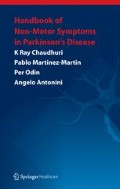Abstract
Parkinson’s disease (PD) patients commonly present with severe or intractable pain, which some patients find more distressing than the motor disability [1]. Furthermore, PD-related pain can present in a variety of types (Fig. 11.1) and, in up to a quarter of patients, chronic pain precedes the onset of motor symptoms or the start of anti-parkinsonian treatment. However, despite being almost ubiquitous, pain in PD patients often remains poorly managed. In one study, 83 % of PD patients reported pain, but only 34 % received analgesics [2].
Access this chapter
Tax calculation will be finalised at checkout
Purchases are for personal use only
Preview
Unable to display preview. Download preview PDF.
References
Hanagasi HA, Akat S, Gurvit H, et al. Pain is common in Parkinson’s disease. Clin Neurol Neurosurg 2010;113:11-13
Beiske AG, Loge JH, Ronningen A, Svensson E. Pain in Parkinson’s disease: Prevalence and characteristics. Pain 2009;141;173-177.
Chaudhuri K, Schapira A. Non-motor symptoms of Parkinson’s disease: dopaminergic pathophysiology and treatment. Lancet Neurol 2009;8:464-474.
Brefel-Courbon C, Payoux P, Thalamas C, et al. Effect of levodopa on pain threshold in Parkinson’s disease: a clinical and positron emission tomography study. Mov Disord 2005;20:1557-1563.
Schestatsky P, Kumru H, Valls-Sole J, et al. Neurophysiologic study of central pain in patients with Parkinson disease. Neurology 2007;69:2162-2169.
Trenkwalder C, Kies B, Rudzinska M, et al; and the RECOVER study group. Rotigotine effects on early morning motor function and sleep in Parkinson’s disease: A double-blind, randomised, placebo-controlled study (RECOVER). Mov Disord 2011;26:90-99.
Kassubek J, Ghys L, Chaudhuri KR, et al; on behalf of the RECOVER study investigators. Transdermal rotigotine improves pain in patients with Parkinson’s disease: a post hoc analysis of the RECOVER Study. Poster presented at: Deutschen Gesellschaft für Neurologie (DGN), 84th Annual Congress; September 28-October 1, 2011; Wiesbaden, Germany.
Park A, Stacy M. Non-motor symptoms in Parkinson’s disease. J Neurol 2009;256:293-298.
Lou JS. Physical and mental fatigue in Parkinson’s disease: epidemiology, pathophysiology and treatment. Drugs Aging 2009;26:195-208.
Larsen JP, Karlsen K, Tandberg E. Clinical problems in non-fluctuating patients with Parkinson’s disease: A community based study. Mov Disord 2000;15:826-829.
Herlofson K and Larsen JP. The influence of fatigue on health-related quality of life in patients with Parkinson’s disease. Acta Neurol Scand 2003;107:1-6.
Beiske AG, Svensson E. Fatigue in Parkinson’s disease: a short update. Acta Neurol Scand Suppl 2010;190:78-81.
Havlikova E, Rosenberger J, Nagyova I, et al. Clinical and psychosocial factors associated with fatigue in patients with Parkinson’s disease. Parkinsonism Relat Disord 2008;14:187-192.
Pavese N, Metta V, Bose SK, et al. Fatigue in Parkinson’s disease is linked to striatal and limbic serotonergic dysfunction. Brain 2010;133:3434-3443.
Chaudhuri KR, Friedman JH, Surmann E, et al; on behalf of the RECOVER study investigators. The effects of transdermal rotigotine on mood/cognition: interpretations from a post hoc analysis of the RECOVER Study using the Parkinson’s disease Non-Motor Symptom Scale. Poster presented at: 15th International Congress of Parkinson’s Disease and Movement Disorders; June 5-9, 2011; Toronto, Canada.
Korczyn AD, Gurevich T. Parkinson’s disease: before the motor symptoms and beyond. J Neurol Sci 2010;289:2-6.
Barichella M, Cereda E, Pezzoli G. Major nutritional issues in the management of Parkinson’s disease. Mov Disord 2009;24:1881-1892.
Kashihara K. Weight loss in Parkinson’s disease. J Neurol 2006;253(suppl 7):VII38-VII41.
Author information
Authors and Affiliations
Rights and permissions
Copyright information
© 2011 Springer Healthcare, a part of Springer Science+Business Media
About this chapter
Cite this chapter
Chaudhuri, K.R. (2011). Other Symptoms. In: Handbook of Non-Motor Symptoms in Parkinson's Disease. Springer Healthcare, Heidelberg. https://doi.org/10.1007/978-1-908517-60-9_11
Download citation
DOI: https://doi.org/10.1007/978-1-908517-60-9_11
Published:
Publisher Name: Springer Healthcare, Heidelberg
Print ISBN: 978-1-907673-23-8
Online ISBN: 978-1-908517-60-9
eBook Packages: MedicineMedicine (R0)

